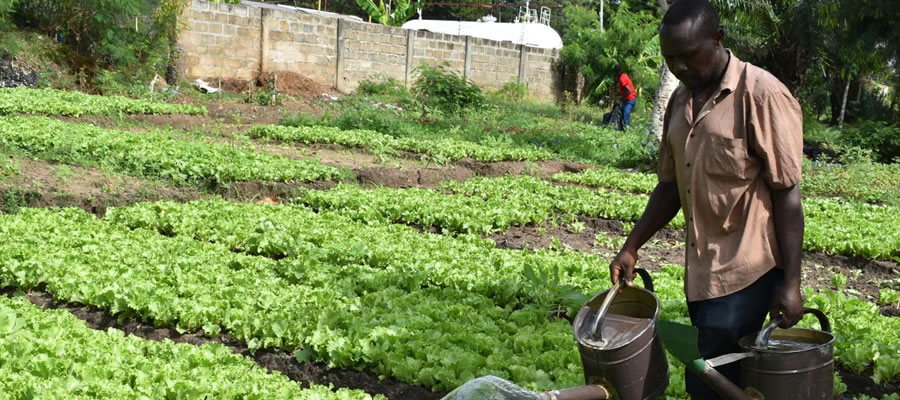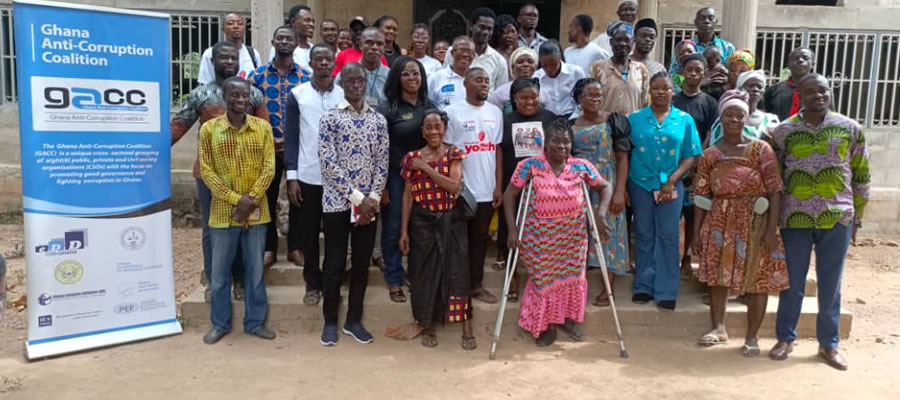

Population
Population Size, Growth Rate and Density
The district projected population size as at 2017 is 108,692 with males being 53,675 whilst females 55,017 (Source: Population Projection (2017), DPCU) with a growth rate of 2.6%.
Population density is defined as the number of people per square kilometer (km2) of unit area of land. The population density in the district is 42.7.0 persons per square kilometer (42.7 persons/km2), which is less than the national figure of 103 persons/km2.
This low density of the district implies that there is low concentration of people in the district and coupled with scattered nature of settlements make it extremely difficult to provide basic services to the people of the district. It also makes monitoring and evaluation of programmes and projects difficult to undertake.
Spatial distribution of Population
There are about 302 settlements in the District. The pattern of the settlement is dispersed as shown in the figure below. There are only five urban settlements and Nsawkaw is the capital of the district. The five urban settlements are Badu with a population of 14,961, Seikwa (11,308), Debibi (8,212), Nsawkaw (8,103) and Brohani (6,663). The rest of the population may be described as rural with population less than 5,000. This means that development projects should be equitably distributed and not skewed in favour of the urban settlements in order to discourage rural-urban migration.
Age and Sex Composition
Analysis of the population structure of the district indicates that about 49.4% of the total population are females whiles 50.6% are males. This resulted in a male – female ratio of 1:0.9 which almost conforms to the regional sex ratio of 1:1.008.
It is generally known that women use a lot of water; so when there is a population structure with so many females, it means water usage level would be very high, hence demand too being very high. Fertility rate tends to be high at areas where the females are many. Hence efforts should be made to promote family planning methods in order to curb population explosion pressure on existing social amenities.
The age structure of the district indicates a broad base and gradually tapers off with increasing age. This picture reflects both the regional and national levels. See the population pyramid below.
The socio – economic survey revealed that 39% of the total population is under 15 years, the economically active population (15-64 years) accounts for 53.3% whiles 7.7% of the population is 65 years and above (65+). The population of the District can therefore be described as youthful .This resulted in an average district dependency ratio of 1: 0.9 (100:90) which is less than the regional dependency ratio of 100:90.5 but higher than the national figure of 100:87. 1.
This implies that 100 persons in the productive age had 90 persons to support in the district. It has also revealed that there are potential labour forces for both agriculture and industrial sectors respectively in the district.
The dependency ratio depicts a positive image; hence the payment of matching funds for the construction of the water facilities and the buying of the water would not be a problem as far as using the ratio for assessment.
Age and Sex Structure
The age structure and the sex composition of the population of the district follow the regional and the national pattern. The age structure is broad at the base and reduces gradually in the subsequent age groups until the population becomes relatively small at the top. Table 1.41 provides information on the age and sex composition by five years age groups for the district. In addition to the absolute numbers, the table provides derived useful information for data users. For example, the data shows that, the age-based dependent population (the dependent population 0-14 and 65 years divided by the population) is about forty six percent (46.1%) of the total population of the district.
Percentages computed from Table 1.41 shows a relatively large proportion of children (13.5%) below five years. The population below 15 years (0-14) is 40.3 percent, the same for children below 15 years for the entire Brong Ahafo region (40.2%). Youth between the ages of 15-19 comprise 10.9% of the total population.
The total population 15-64 years (conventionally referred to as the labour force) is 53.9 percent of the total population implying a large base of population available to be harnessed for productive work.
Taking the population in the 15-64 age group only, a little over one forth (26.7%) is below 30 years; while 11.7 percent is between the ages of 30-39 years. About eight percent (8.1%) is between 40-49 years and about seven percent (7.4%) is above fifty years. Significantly therefore, the data shows that about forty seven percent (46.5%) of the population referred to as the labour force is below forty years.
The proportion of the older persons 65 years and older of 5.8 percent is however higher than the 4.4 percent recorded for the entire Brong Ahafo Region.
In relation to the sex structure, there are more males (50.7%) than females (49.3%) who are under 15 years in the district just as was observed for the region (males, 51.1%, females, 48.9%)
The urban-rural distribution according to age follows a similar pattern as the sex structure. A large proportion of both urban (38.3%) and rural (42.3%) dwellers are under age 15 years (0-14).
In terms of the population (15-64 years) by urban-rural distribution, there are equally higher percentages of the population falling within that category. That is, urban (55.2%) and rural (52.3%).
Unlike the pattern for the age structure for the population in the age group 15-64 years, around one fourth of both urban (28.7%) and rural (24.7%) dwellers are below thirty years.
Also, those above age 50 in the labour force are relatively small. That is 7.4 percent for urban and 7.4 percent for rural.
Sex Ratio
The sex ratio is defined as the number of males per 100 females. The sex ratio at birth for most countries is about 105 or 106 males per 100 females. After birth, sex ratio varies because of different patterns of mortality and migration for males and females within the population. Sex ratios that are higher than 100 indicate that there are more males than females but sex ratios under 100 indicate that there are more females than males.
Throughout life, it is expected that at every age, mortality rates for females will be lower than that of males. Therefore the sex ratio(s) for any population should decline from one age group to the other with advancing age.
Table 1.42 also shows that the overall sex ratio is 97.7 percent, implying that for every 100 females in the district, there are almost 98 males. For the Tain District, the subsequent sex ratios after the overall sex ratio do not follow the expected pattern of steady and gradual decline with advancing age as revealed by the ratios for age groups 5-9years, 10-14 years, 15-19years and 55-59 years. The District’s large and fluctuating sex ratios with visible through suggest age misreporting, under-enumeration, out- migration or differential mortality. The generally low sex ratios, especially after the age group 70-74 years demonstrate the validity of the observation that women live longer than men.
Age Dependency Ratio
The age-dependency ratio is the ratio of people in the “dependent” ages (those under age 15 and ages 65and older) to those in the “economically productive” ages (15 to 64 years) in a population.
The age-dependency ratio is often used as an indicator of the economic burden the productive portion of a population must carry. Countries with very high birth rates usually have the highest age-dependency ratios because of the large proportion of children in the population. The age dependency ratio is a theoretical construct because many of the population 15-19 years for example are dependent because they are in school. Equally, not all persons 65years and over are dependent as can be demonstrated from the aged farmers, fishermen and artisans in the district. Age dependency therefore is not synonymous with economic dependency.
Table 1.45 shows that Tain District has an age dependency ratio of 85.4 percent implying that, for every 100 persons in the working age group, 85 persons depend on them. It can also be observed that the male age dependency ratio of 85.2 percent is slightly lower than the female age dependency ratio which is 85.7 percent.
Population pyramid
A population pyramid is a graphical representation of the age-sex composition of a population and its shape is influenced by the levels of fertility, mortality, migration and coverage and content errors such as digit preference and exaggeration of age.
The broadness of the base is determined by the level of fertility, while the shape is determined by mortality and to some extent migration.
The age-sex structure is graphically represented by the pyramid in Figure 5. In general, the population pyramid reflects a broad-base pattern, characteristic of a developing nation with over half of its population for both males (41.7%) and females (38.1%) being young and under 15 years of age. This type of age structure has a built-in momentum for the growth of the district’s population. When the young population eventually reaches reproductive age, the result will be a high population growth rate for some years to come.
However, if the socio-economic potentials of the youth are properly harnessed and directed, they could contribute significantly to development of the district and the nation as a whole.
The pyramid generally shows the expected pattern of declines in the length of the bars for each group with advancing age. However, some ages do not follow this expected pattern. For instance, the bars for the age group 0-4 are shorter than those for 5-9 males and 65-69 also shorter than 70-74 years for both males and females.
Migration (Emigration and Immigration)
Internal migration has played an important role in spatially redistributing the population of Ghana. Migrants tend to contribute directly to population decrease in the areas of origin or increase in the destination areas. Migration is also selective with regard to age, sex and therefore productive capacity. Thus, migration has significant demographic, social and economic impact on both the areas of origin and destination.
A total of 19,452 persons have migrated into the Tain District. This is about one in five (22.1%) of the total population of the district (87,994). The table reveals that 7,030 representing 36.1 per cent were born elsewhere. Migration has its own effect on development in the District. From the facts and figures, one can see many persons migrating into the District in recent years. This has put more pressure on the available socio-economic facilities. There is therefore the need to plan for the migrants and see how best to make good use in terms of their human resource capacity to enhance development.
Gender equality
Gender analysis mainly centres on men, women, boys and girls in the society. It encompasses the societal roles and responsibilities of men, women, boys and girls as well as power relations between them. The analysis measures the extent to which gender gaps exist among issues such as opportunities, needs, rights, voices, participation, access to resources, control of resources and decision making.
It provides information on the different roles of women and men at different levels; their respective access to and control over the material and non-material benefits of society; their priorities, needs and responsibilities. It shows the linkages between inequalities at different societal levels; needs assessment is a vital component of gender analysis. Needs analysis is a necessary step when identifying appropriate strategies for the promotion of gender equality.
The roles and responsibilities of men and women are based on the various activities performed by both in the society. Men’s and women’s activities are identified as either “reproductive” or “productive” types, and these activities reflect access to and control over income and resources in the community. Under the productive work, women are often engaged in activities which fetch them small remuneration.
They are mostly involved in wage labour, subsistent farming, crafts and so on. With regards to reproductive work, they are engaged in childbearing and rearing, domestic tasks that guarantee the maintenance and reproduction of the current and future work force, for example, cooking, cleaning and so on. They are also engaged in care and maintenance of the household and its members (bearing and caring for children, food preparation, water and fuel collection, shopping housekeeping and family health care).
Works which are seldom considered ‘real work’ and are usually unpaid are most at times the responsibilities of girls and women. As a result of this, women and girls have minimal access and control over resources like land, education, equipment, labour, cash from sales, extension services, training, agriculture inputs, irrigation, technology and credit.
On the issue of credit, both women and men have different credit needs for income generation and other expansion schemes. Women control money for small household items, but men control income for larger items; and they tend not to know about their rights in applying for loans in the communities.
It is considered not feminine if women ask for credit. Men generally own land and other fixed capital. One needs to be able to read and write to fill the loan forms, and there tend to be more illiterate women than men. Women have low self-esteem and view men in lending institutions and also in NGOs as ‘big and important’.
One the basis of the aforementioned, women tend to enjoy small benefits when it comes to income, ownership of resources, basic needs, extension services, decision making, prestige, agriculture inputs, irrigation, technology and credit.
Settlement systems
An examination of the settlement system and spatial linkages between settlements was carried out to find out the nature and distribution of economic and social facilities in the district.
The distribution of services in the district was analyzed by employing the scalogram technique. A scalogram is a matrix presentation of the functional structure of settlements. The spatial distribution of services in the district is presented in the table below as well as in the map on hierarchy of settlements which is a spatial depiction of the scalogram analysis.
In all 15 settlements with populations above 800 in 2014 were considered with the total number of service being 35. The district has two first order settlements namely Badu with a population of 13,435 and Seikwa (10, 1196). Nsawkaw, the district capital (6,569) has 26 services out of the 35 service under consideration and it is the only second order settlement.
Debibi, Brodi and Brohani with a population of 7,318, 4,610 and 6,105 respectively, etc with 8 – 19 services out of the 35 representing are among the third order settlements. Thus eight settlements are in the level three ranking. 11 settlements passed as level four settlements having services ranging between 1 and 7. The settlements that fall under this level are Atomfourso (2,535), Tainso(1,176) and Nkorankwagya (1,754), etc. The details are shown in the table 1.16 below.
Date Created : 11/20/2017 5:51:17 AM












 facebook
facebook
 twitter
twitter
 Youtube
Youtube
 +233 593 831 280
+233 593 831 280 0800 430 430
0800 430 430 GPS: GE-231-4383
GPS: GE-231-4383 info@ghanadistricts.com
info@ghanadistricts.com Box GP1044, Accra, Ghana
Box GP1044, Accra, Ghana